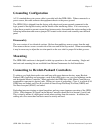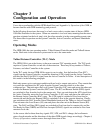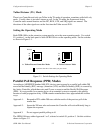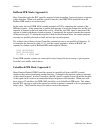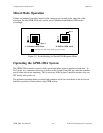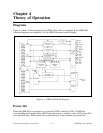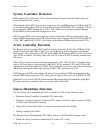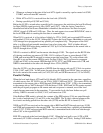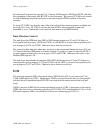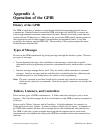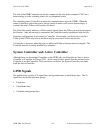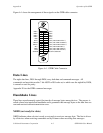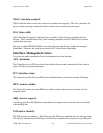Chapter 4 Theory of Operation
© National Instruments Corporation 4-3 GPIB-100A User Manual
• Whenever a change in the state of the local ATN signal is caused by a pulse created via U38E,
U24B/C, and associated RC network.
• While ATN or DAV is received from the local side (U34A/D).
• During a parallel poll (U38F and U34A).
Before the LS FF is set and unless a parallel poll is in progress, the unit drives the local Not Ready
for Data (NRFD) signal passively false (U42C and U41C). After the Active Controller is
identified and before the Source Handshake is identified, the unit drives Not Data Accepted
(NDAC) signals (U42B and U41D) true. Thus, the unit appears in a normal RFD/NDAC state to
the local GPIB which is awaiting the first data or command byte.
When DAV is received, it is first delayed slightly by U23A, U48E, and associated RCD network
and enabled (U25A) to the LS FF. Setting the FF causes the Local Source Handshake to wait until
ATN changes have propagated and any parallel poll completes fully. The purpose of the DAV
delay is to filter tail-end unstable transitions from a fast rising edge. DAV is further delayed
through U23B/C/E/F before being enabled at U25C by LS to be transmitted to the remote side as
XDAV through driver U30B.
XDAV is received as RDAV on the remote side through U19D. The signal sets the RS FF after
all clearing conditions are removed (U35B). DAV is delayed 2 µsec or more through U38C,
U48B, and associated RCD network to ensure proper data setup time (T1) on the remote side.
Once RS is set and the remote GPIB is ready for data (U46A), DAV is allowed to propagate
(U46D and U36C) to the remote GPIB through U47D, U27C, and GPIB transceiver U1B, and
NRFD is transmitted to the other side through driver U30A (XRFD).
Once the LS FF is set, the propagation of NRFD from the remote side sets FF U36A via receiver
U19A, U44C, and U35A. At this point, the unit drives the NRFD and NDAC lines according to
the levels sensed at the remote unit (via U42C,U41A/D, and GPIB transceiver U1C for NDAC).
Parallel Polling
When the local unit detects ATN and End Or Identify (EOI) asserted at the same time, regardless
of which occurs first, FF U45D is set via U26A, U44E, U48D, and U43C. This causes EOI to be
transmitted to the remote side as XEOI through U46B and driver U30C. ATN is also transmitted
to the remote side as XATN through U43D and driver U29B. XEOI and XATN remain asserted
until the poll signals propagate to the remote unit and a response is returned, even if the local
signals become unasserted in the meantime. To prevent the local side from further non-poll
activity, NRFD is asserted via U46C, U41C, and transceiver U1D.
If the Buffered PPR mode is selected, the contents of the PPR register (U16) are routed through
the A side of multiplexers U13 and U14 to the local GPIB. The A side is selected whenever the
local unit is not being polled from the other side (U27B) and the RS FF is cleared (U47A).
XEOI and XATN are received on the remote side as REOI and RATN through receivers U19B
and U20B and propagated to the remote GPIB. Two microseconds later, a parallel poll handshake
signal (U27C, U38A, and associated RCD network) is transmitted back to the local side through
driver U8C as the signal BUS PP.
BUS PP is received at the local unit through U10C. When the local poll is over (ATN or EOI
unasserted), FF U45B is cleared and U36D is set (via U37B/C and U26A). Setting U36D latches




